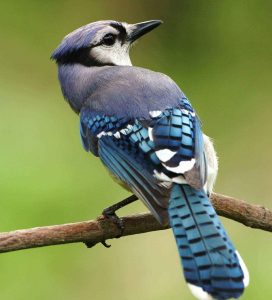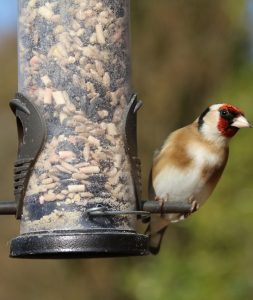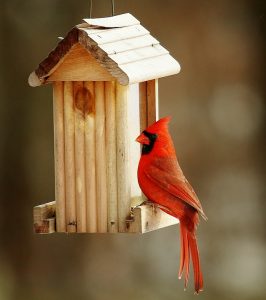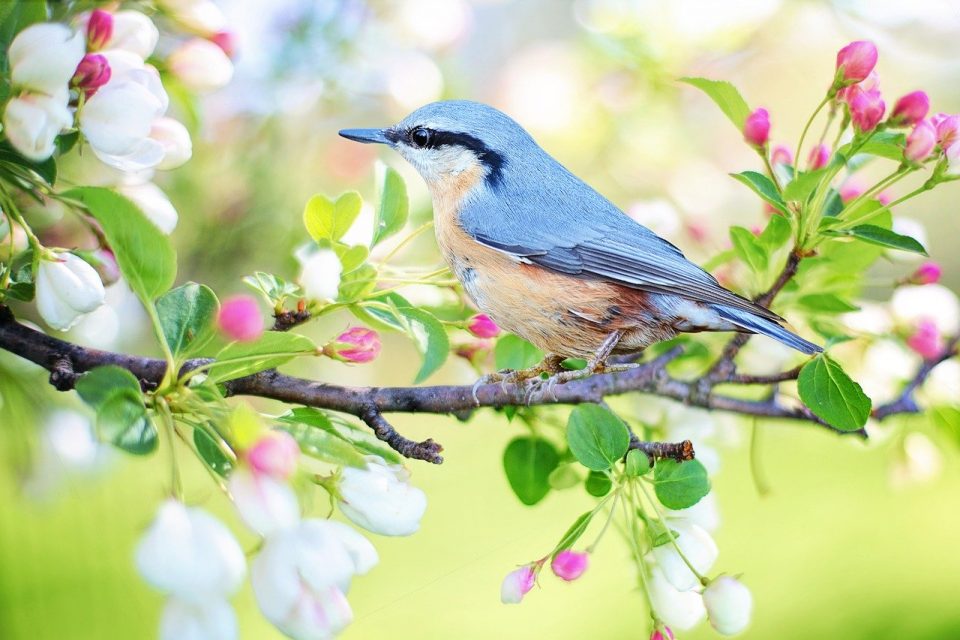My name is Megan, and I know cardinals like the back of my hand – they’re my state bird for reason after all!
They’re lovely songbirds, and they carry a reputation of symbolism and myths wherever they fly.
Nesting pairs spend their days feeding and singing to each, and, once they have chicks, you can watch both parents tend to their young which is a magical experience.
Not too mention that these vibrant red birds are simply beautiful.
Every year, I plan my garden around attracting as many of these lovely little birds to my yards as possible, and now I’m sharing these tips with you.
Cardinals don’t usually migrate. Once they find a secure location to nest that offers enough resources to fulfill their needs, they tend to stay there.
That means that if you manage to attract a cardinal – or, even better, a mating pair! – to your garden and keep it, then, as long as you continue making sure it has food, water, and shelter, then it will continue to nest there.
From certain plants and foilage to investing in the right bird food, attracting cardinals to your garden – and keeping them there – can be easy once you know exactly what you’re looking for.
What Do Cardinal Birds Look Like?
 When you think of cardinals, you most likely think of vibrant red feathers and dark masks. Well, that’s not entirely true.
When you think of cardinals, you most likely think of vibrant red feathers and dark masks. Well, that’s not entirely true.
You see, cardinals are a great example of a phenomenon known as sexual dimorphism. That simply means that males and females of the same species look different.
So, that holiday card image of a cardinal you have in your head is a cardinal – but only the male.
Male cardinals have a beautiful, bright red plumage, with orange beaks and black facial markings. It’s this bright red coloration that helps these birds attract a mate.
Depending on the season as well as the male’s diet and health, their feathers may be on the dark end of the spectrum with more brownish hues.
A vibrant, bright coat of feathers, much like a lion’s mane, shows off how healthy a male cardinal is – an attribute of a good mate.
Since female cardinals don’t have to prove themselves as a proper mate, they lack this coloration.
Female cardinals have the same orange beaks and black facial markings, but their plumage is much duller.
You’ll find that females are normally a greyish-brown with light bellies, though they can have hints of red in parts of their feathers such as their head plume and the tip of their wings and tails.
Both males and females are around the same size and have the same feather style.
What Time of Year are Cardinals Around?
You can find cardinals year-round! Their red plumages are especially beautiful in the fall and winter, and, in the warmer months, you can listen as they sing to their mates and raise chicks.
However, with each season, their needs change. During the spring and summer, you most likely won’t find more than a pair or two in your yard.
Cardinals are monogamous – meaning that they breed with the same mate each year – and extremely territorial, so they have a tendency to scare off potential competition.
During the colder months when food is scarce and the nests are empty, though, you’ll often see them flocking towards food sources.
How to Attract Cardinals to Your Garden?
While bird feeders are one good way to attract cardinals to your garden, they’re not the only way.
From planting the right plants to offering other necessities such as water, making sure that your garden has what cardinals need can attract them.
What Plants Attract Cardinals?
One of the most important things to know about cardinals is that they’re not like other birds: they won’t nest in birdhouses.
Cardinals prefer to nest in dense, covered areas. These areas offer the most protection in the wild, so it is where they feel the most secure.
To replicate this natural safe-zone in your garden, try to plant thickets of dense vines and shrubs. To help with your natural landscaping, here are some of the best plants for cardinals:
 Grapevines
Grapevines- Clematis
- Dogwood
- Sumac
- Mulberry
- Blueberry
Once you provide a safe area for the cardinals to rest, you may want to consider leaving out some nesting supplies as well as a food source.
You can also leave out plant matter such as small twigs, pine needles, and grass clippings to help and encourage the cardinals to build nests.
Some of the plants listed above, such as mulberry and blueberry, can also double as a food source.
What Else Should You Put in Your Garden?
A garden for bird watchers is for more than just dense plants and nice feeders. Cardinals have three main needs that need to be met for them to choose your garden as a permanent residence.
First, they need shelter, which can be covered by the plants listed above since cardinals won’t use a birdhouse.
The second need, food, can be covered by these plants too, as well as bird feeders. However, cardinals will still need water.
That means that you will need to put a birdbath into your garden as well. This will act as both a water source and a place for your birds to bathe.
What Shouldn’t You Put in Your Garden?
Planning your landscape and the plants you use is only half the process of making sure your garden is cardinal-friendly. There are also a few things that you should avoid.
Obviously, you should make sure your garden has no harmful chemicals.
While it may be tempting to use insecticides and fertilizers to keep your garden maintained, these can be extremely harmful to the animals in your garden – and not just cardinals.
You should also avoid allowing your pets to roam in your garden. Cardinals are ground feeders and are vulnerable to animals and pets such as cats.
You should also avoid scattering seeds around bushes where predators can hide and attack the cardinals while they eat.
Finally, you should avoid having reflective surfaces in your garden. As mentioned above, cardinals, especially males, are extremely territorial and aggressive.
They also cannot distinguish their own reflection from a potential competitor. This means that if a cardinal in your garden sees their reflection, they make feel threatened and will leave.
It can also cause them harm and can even damage their beaks.
To prevent this, use screens to cover windows without blocking your view or add distractions to help cardinals feel more secure in your garden.
6 Best Cardinal Bird Feeders
1) Perky-Pet Red Cardinal Feeder
The Perky-Pet feeder can be described in three words: rustic, simple, and convenient.
It’s designed to support both clinging birds and perching birds such as cardinals, and, thanks to fact its made completely out of metal with no plastic or wood, it’s durable and will last for a long time.
It has a 2.5-pound capacity, making it perfect for black oil sunflower seeds or any other popular bird food.
The convenience of this cardinal feeder comes into play with both is collapsable time and its wide-mouth opening that makes for easy, mess-free refilling.
The large overhanging provides shelter for the birds as they eat while also protecting the food from the elements so you don’t have to worry about mold or other harmful fungi that would harm the birds.
The perch also has drain holes to keep water from pooling. One of the only issues with this feeder is, despite its heavy-gauge metal mesh, squirrels can bite through the mesh given the chance.
In this instance this does happen, however, it can easily be fixed using pliers.
2) Brome Squirrel Buster Standard Perches
While this cardinal feeder is a bit more on the expensive side, it does offer quite a few benefits outside of just proving a great place for perching and clinging birds to eat.
First, Brome offers lifetime care meaning that if something does happen to your feeder, you won’t have to throw it away – Brome guarantees service to help make sure your cardinal feeder is in top shape.
It is also squirrel proof so that you can save money on seeds while also not worrying about squirrels causing damage or scaring off hungry birds.
The shroud has a weight sensor, and, when an adult squirrel lands on the feeder to try and steal the food, the shroud will automatically close.
The Brome Squirrel Buster also features a seed ventilation system that will keep seeds fresh, keeping the cardinals in your garden happy.
The only thing to keep in mind when purchasing this cardinal feeder is that you will have to take it down and disassemble it to refill it with more bird food.
3) Perky-Pet Holly Berry Gilded Bird Feeder
If you’re looking for a budget feeder that will get the job done and keep cardinals in your garden, then the Perky-Pet feeder is a great option.
It has a 360 degree perch so that birds can feed from any angle, and it can hold up to two pounds of seeds.
With its gilded holly berry design, this feeder is also very aesthetic and will look great at any home.
Its greatest feature, however, is the patented Sure-Lock cap that makes for easy filling without worrying about any seeds spilling.
It’s also easy to known when the feeder needs to be refilled thanks to the clear seed reservoir.
The only thing to remember is that, because the seeds are contained in plastic, you may need to replace them more often to keep them fresh.
4) RoamWild PestOff Bird Feeder
Blackbirds, squirrels, chipmunks – animals such as these can make it difficult to have a garden full of cardinals.
The RoamWild feeder takes this into consideration and has been designed to keep these pests away from your birds and their seeds.
It also keeps away some other natural pests such as rust and water damage.
It holds three pounds of seeds, so you don’t have have to worry about refiling seed soften – although, when you do, refilling is easy.
There’s no nuts or bolts and no need for tools with a simple tube that attached and detaches with just a few clips.
This bird feeder also comes in a variety of colors so that you can pick the perfect style to fit your garden. From red to blue to green to yellow, you can find the perfect color.
It also comes with a hassle-free warranty, ad, if you’re not, 100% satisfied, you can get your money back.
If you’re truly worried about how well the RoamWild PestOff bird feeder will fend against pests, RoamWild offers a video showing how the feeder holds up against a wild squirrel.
5) North States Village Collection School House Bird Feeder
If you’re looking for a great gift for bird lovers or looking for something cute and rustic to liven up your landscape while attracting cardinals, then this school-house style bird feeder is the best choice for you.
Inexpensive and functional, this charming little feeder holds up to five pounds of bird seeds, meaning that you don’t have to refill this feeder as often as you would with a smaller one.
While it’s sturdy, you don’t have to worry about not knowing when it isn’t time to refill this feeder: the windows function just like real ones so you can see into the seed reservoir.
6) More Birds X-1 Squirrel Proof Feeder
If you get lucky enough to have multiple cardinals in your garden, you may find that a smaller feeder without enough areas doesn’t work as well.
In that case, you may want to invest in this bird feeder. It has a 4.2 pound seed capacity as well as four feeding ports with perches, making it perfect for multiple cardinals.
It has a wide mouth to make refilling easier. One of the best features, however, is the fact that this bird feeder is squirrel-proof.
The only thing that may be a negative attribute is that this feeder is created completely out of plastic, so you will need to make sure that it is not directly exposed to the elements by putting it under a shelter.
What to Put in Your Cardinal Bird Feeders?
While cardinals are natural ground eaters satisfied with most things they find, they do have one favorite food in particular: black oil sunflower seeds.
You can fill your bird feeders with these little delicacies or scatter them on the ground – they’ll be happy either way. They also enjoy peanuts, cracked corn, and fresh berries.
How to Set Up Your Cardinal Bird Feeders
As mentioned above, cardinals are ground feeders, so set up your new bird feeder closer to the ground, no more than 5 feet in the air.
These sweet little birds also need water, so set up a birdbath 2 to 3 inches away from your feeder.
If you have any pets such as cats, make sure that you set up the feeder where the cardinals will not be in harm’s way while eating.
Top Picks
My overall top pick is the Brome Squirrel Buster. Despite the fact it’s a bit more expensive and has to be taken apart to refill, I really like the rust and squirrel proof design. I also like the guaranteed lifetime care.
Bird feeders stay outside and are constantly exposed to the elements, so I feel like a bird feeder that is both sturdy and easy to fix is important rather than having to purchase a new feeder at the end of every season.
My top budget pick is the Perky-Pet holly berry gilded feeder. For an inexpensive price, it offers both an innovative and aesthetic bird feeder.
I think that it’s perfect for both novice and seasoned bird feeders, and it also makes a perfect gift.
My top aesthetic pick would be the North States Village Collection bird feeder. With its charming rustic aesthetic, it’ll make a beautiful addition to any home.
It’s also extremely functional, though. With its five pound seed capacity, its windowed seed reservoir, and its perch, it’s perfect for all bird lovers.
Final Thoughts: Best Cardinal Bird Feeders
 Cardinals are amazing birds with a lot of symbolism.
Cardinals are amazing birds with a lot of symbolism.
Due to the fact that they mate for life and spending their time singing to and feeding their mates, these birds symbolize loyalty and faithfulness and having them in your garden is a wonderful experience.
Thankfully, bringing them into your garden and keeping them there isn’t as difficult as it seems.
The first thing you want to do is to make sure you design your landscape – from your plants to your decorations – is cardinal-friendly.
Plant dense vines and shrubs and avoid things such as harsh chemicals and reflective surfaces. Picking out the perfect cardinal bird feeders is just the icing on the cake.
By making sure that they have a constant, healthy food source, you can help ensure that there will always be a cardinal or two nesting in your garden.



